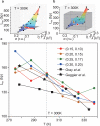An associative memory Hamiltonian model for DNA and nucleosomes
- PMID: 36972316
- PMCID: PMC10079229
- DOI: 10.1371/journal.pcbi.1011013
An associative memory Hamiltonian model for DNA and nucleosomes
Abstract
A model for DNA and nucleosomes is introduced with the goal of studying chromosomes from a single base level all the way to higher-order chromatin structures. This model, dubbed the Widely Editable Chromatin Model (WEChroM), reproduces the complex mechanics of the double helix including its bending persistence length and twisting persistence length, and the temperature dependence of the former. The WEChroM Hamiltonian is composed of chain connectivity, steric interactions, and associative memory terms representing all remaining interactions leading to the structure, dynamics, and mechanical characteristics of the B-DNA. Several applications of this model are discussed to demonstrate its applicability. WEChroM is used to investigate the behavior of circular DNA in the presence of positive and negative supercoiling. We show that it recapitulates the formation of plectonemes and of structural defects that relax mechanical stress. The model spontaneously manifests an asymmetric behavior with respect to positive or negative supercoiling, similar to what was previously observed in experiments. Additionally, we show that the associative memory Hamiltonian is also capable of reproducing the free energy of partial DNA unwrapping from nucleosomes. WEChroM is designed to emulate the continuously variable mechanical properties of the 10nm fiber and, by virtue of its simplicity, is ready to be scaled up to molecular systems large enough to investigate the structural ensembles of genes. WEChroM is implemented in the OpenMM simulation toolkits and is freely available for public use.
Copyright: © 2023 Lu et al. This is an open access article distributed under the terms of the Creative Commons Attribution License, which permits unrestricted use, distribution, and reproduction in any medium, provided the original author and source are credited.
Conflict of interest statement
The authors have declared that no competing interests exist.
Figures




Similar articles
-
Free energy profiles for unwrapping the outer superhelical turn of nucleosomal DNA.PLoS Comput Biol. 2018 Mar 5;14(3):e1006024. doi: 10.1371/journal.pcbi.1006024. eCollection 2018 Mar. PLoS Comput Biol. 2018. PMID: 29505570 Free PMC article.
-
Nucleosome spacing periodically modulates nucleosome chain folding and DNA topology in circular nucleosome arrays.J Biol Chem. 2019 Mar 15;294(11):4233-4246. doi: 10.1074/jbc.RA118.006412. Epub 2019 Jan 10. J Biol Chem. 2019. PMID: 30630950 Free PMC article.
-
Characterization of nucleosome unwrapping within chromatin fibers using magnetic tweezers.Biophys J. 2014 Jul 15;107(2):373-383. doi: 10.1016/j.bpj.2014.05.036. Biophys J. 2014. PMID: 25028879 Free PMC article.
-
DNA Mechanics and Topology.Adv Exp Med Biol. 2018;1092:11-39. doi: 10.1007/978-3-319-95294-9_2. Adv Exp Med Biol. 2018. PMID: 30368746 Free PMC article. Review.
-
Computational modeling of the chromatin fiber.Semin Cell Dev Biol. 2007 Oct;18(5):659-67. doi: 10.1016/j.semcdb.2007.08.011. Epub 2007 Aug 25. Semin Cell Dev Biol. 2007. PMID: 17936653 Review.
Cited by
-
Predicting scale-dependent chromatin polymer properties from systematic coarse-graining.Nat Commun. 2023 Jul 11;14(1):4108. doi: 10.1038/s41467-023-39907-2. Nat Commun. 2023. PMID: 37433821 Free PMC article.
-
Nucleosomes play a dual role in regulating transcription dynamics.Proc Natl Acad Sci U S A. 2024 Jul 9;121(28):e2319772121. doi: 10.1073/pnas.2319772121. Epub 2024 Jul 5. Proc Natl Acad Sci U S A. 2024. PMID: 38968124 Free PMC article.
References
-
- Wilkins MHF, Stokes AR, Wilson HR. Molecular Structure of Nucleic Acids: Molecular Structure of Deoxypentose Nucleic Acids. Nature. 1953. Apr;171(4356):738–40. - PubMed
Publication types
MeSH terms
Substances
Grants and funding
LinkOut - more resources
Full Text Sources

